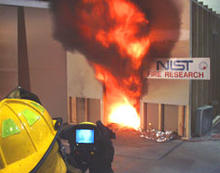Structural Safety in Hurricanes, Fires, and Earthquakes
Problem/Challenge

Each year, the United States suffers an estimated $52 billion in property damage, disruption of commerce, and lost lives due to natural disasters such as hurricanes, wildland fires, and earthquakes. A single major event—a big earthquake or hurricane—potentially could cause some $80 billion to $200 billion in economic losses in the affected areas.
The tragedy caused by Hurricanes Katrina and Rita in August and September 2005 underscores the growing risk to society from natural disasters. One important way in which we can reduce these costs and mitigate the loss of human life and property is by making our structures—buildings, bridges, tunnels—as well as our key utility networks—electric power, water, sewage, communications, financial and data networks—more resilient and resistant to disasters. This requires both developing a scientific basis for design decisions and translating that science into practice. Current building design practices, for example, do not attempt to consider how well a structure would perform in an uncontrolled fire because there is no accepted science-based set of tools to evaluate the fire performance of entire structures under realistic fire conditions.
Proposed NIST Program
NIST is an internationally recognized leader in researching and understanding the effects of earthquakes, wind, wildfires, and other extreme events on structures. NIST works with other government agencies, universities, and the private sector to develop technologies, tools, standards, and practices to better predict the extent of damage from natural disasters, mitigate their impact, and help prevent structural and infrastructural failures in their wake.
The goals of this initiative are to develop:
- the technical tools required to enable innovations in multi-hazard risk assessment and mitigation technologies, and
- the scientific basis to improve the codes and standards used in the design, construction, and retrofit of buildings and physical infrastructure.
The National Science and Technology Council has set six Grand Challenges for mitigating losses due to disasters, and under this initiative NIST will address four areas where it has particular expertise. Specific research goals include:
- an extreme wind database and other tools to plan for hurricanes and other extreme wind events,
- methods to predict fire and smoke behavior at the wildland-urban interface,
- more robust seismic design and construction methods for building earthquake-resistant structures, and
- failure analysis and mitigation tools for predicting a building's capacity to withstand multiple hazards.
Expected Impacts
This research effort should result in:
- science-based tools for improving fire-fighter and emergency management official training, resource allocation decisions, and hazard mitigation assessments;
- improved information for development of model building codes and the next generation of seismic, wind, and fire codes; and
- better technical resources such as guidelines, manuals, and code commentaries for use in structural engineering practice.

